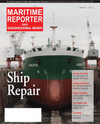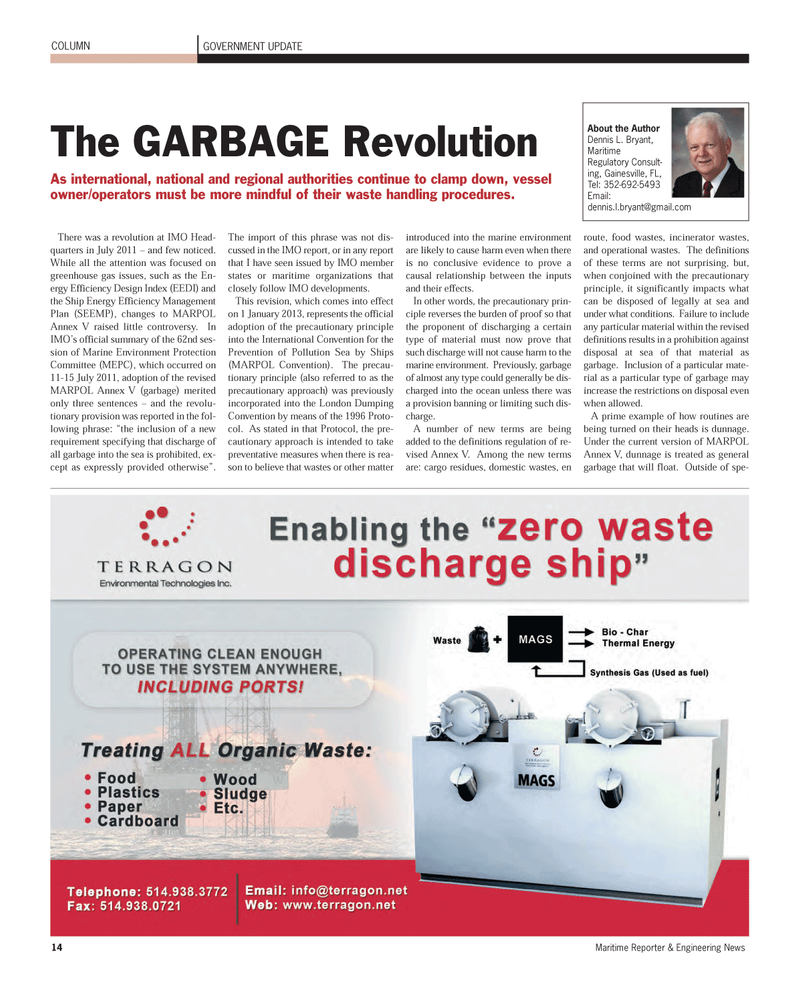
Page 14: of Maritime Reporter Magazine (March 2012)
The Ship Repair Edition
Read this page in Pdf, Flash or Html5 edition of March 2012 Maritime Reporter Magazine
14Maritime Reporter & Engineering News There was a revolution at IMO Head- quarters in July 2011 ? and few noticed. While all the attention was focused on greenhouse gas issues, such as the En- ergy Efficiency Design Index (EEDI) and the Ship Energy Efficiency Management Plan (SEEMP), changes to MARPOLAnnex V raised little controversy. In IMO?s official summary of the 62nd ses- sion of Marine Environment Protection Committee (MEPC), which occurred on11-15 July 2011, adoption of the revised MARPOL Annex V (garbage) merited only three sentences ? and the revolu- tionary provision was reported in the fol- lowing phrase: ?the inclusion of a new requirement specifying that discharge of all garbage into the sea is prohibited, ex- cept as expressly provided otherwise?. The import of this phrase was not dis- cussed in the IMO report, or in any report that I have seen issued by IMO member states or maritime organizations that closely follow IMO developments. This revision, which comes into effect on 1 January 2013, represents the official adoption of the precautionary principleinto the International Convention for the Prevention of Pollution Sea by Ships (MARPOL Convention). The precau- tionary principle (also referred to as theprecautionary approach) was previously incorporated into the London DumpingConvention by means of the 1996 Proto- col. As stated in that Protocol, the pre- cautionary approach is intended to take preventative measures when there is rea- son to believe that wastes or other matter introduced into the marine environment are likely to cause harm even when there is no conclusive evidence to prove a causal relationship between the inputsand their effects. In other words, the precautionary prin- ciple reverses the burden of proof so that the proponent of discharging a certain type of material must now prove that such discharge will not cause harm to the marine environment. Previously, garbage of almost any type could generally be dis- charged into the ocean unless there was a provision banning or limiting such dis- charge. A number of new terms are being added to the definitions regulation of re- vised Annex V. Among the new terms are: cargo residues, domestic wastes, en route, food wastes, incinerator wastes, and operational wastes. The definitions of these terms are not surprising, but, when conjoined with the precautionaryprinciple, it significantly impacts what can be disposed of legally at sea and under what conditions. Failure to include any particular material within the revised definitions results in a prohibition against disposal at sea of that material asgarbage. Inclusion of a particular mate- rial as a particular type of garbage may increase the restrictions on disposal even when allowed. A prime example of how routines are being turned on their heads is dunnage.Under the current version of MARPOL Annex V, dunnage is treated as general garbage that will float. Outside of spe- COLUMNGOVERNMENT UPDATE The GARBAGE RevolutionAbout the AuthorDennis L. Bryant,Maritime Regulatory Consult-ing, Gainesville, FL,Tel: 352-692-5493 Email:[email protected] international, national and regional authorities continue to clamp down, vessel owner/operators must be more mindful of their waste handling procedures. MR March 12 # 2 (9-16):MR Template 3/6/2012 10:42 AM Page 14

 13
13

 15
15
